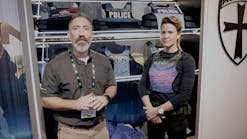A little over two years ago, Beacon, New York, police officer Anthony Hopper was dispatched to a suspicious person in a vehicle complaint. It was a 1:50 in the afternoon on a beautiful, sunny autumn day. That's how Hopper remembers it.
"It's not the time that you'd figure you'd be in the middle of a gun fight," recalls Hopper, "But that's what took place."
Almost immediately after Hopper engaged the driver, the driver produced an automatic handgun and shot him point-blank through the driver's side window. The bullet struck Hopper in the center of the chest. Doctors told him that had the bullet penetrated the armor and gone through, it most likely would have killed him.
In an effort to continue to serve all those in the line of fire, the U.S. Department of Justice is currently working to unveil a newly updated standard for all body armor. Ballistic Resistance of Body Armor NIJ Standard 0101.06 will test ballistic materials against the most rigorous requirements. In partnership with all body armor manufacturers, the revised NIJ Standard 0101.06 aims to review armor classifications, detail requirements and discuss test methods in order to produce the safest ballistic wear yet.
Weighing inDespite having survived the shooting, Hopper was not without physical scars. Shards of glass flew from the window and created over 60 lacerations to his face and neck. Hopper also says it took him a long time to heal from the soreness created by impact. Soft material vests capture rounds and prevent them from going any further. But as Hopper points out, "expelled energy from the round has got to be absorbed somewhere. It's possible the blunt trauma, depending on the round, can kill an officer if the round doesn't penetrate the vest;" which is why he thinks it's imperative that manufacturers and the NIJ continue to explore what they can do to dissipate that energy.
Personal armor covered by the new standard is classified into five types: (IIA, II, IIIA, III and IV), by level of ballistic performance. New vests will be heavier, bulkier and more expensive than before. But a heavier vest doesn't necessarily mean officers will be more weighed down. Tom Dragone, vice president of research and development at Point Blank Solutions, feels heavier armor will cause some wearers to shift levels in order to keep the feel of what they normally use. In general, a IIA vest will weigh the same as a current level II, and will stop the same threats as before.
"It's kind of an adjustment of what level you really need, and a trade-off between protection and comfort. In the past when armor was too heavy officers just didn't wear it. And armor that's not worn can't protect you," says Dragone.
Georg Olsen, general manager of U.S. Armor, agrees. He stresses that the new design will not cancel out older models that may still be in use. "It's a phase-in. It doesn't mean the other [models] are bad," says Olsen. He adds that he's "still challenged to find a safety product with that many years of unmitigated success [as ballistic vets]."
Hopper doesn't care how heavy or uncomfortable his vest is, as long as it protects. "It hurts a lot more when you're shot than it does sitting in a car and having the unfortunate eight hours of sweating and being uncomfortable," says Hopper. "Obviously, the lifetime ramifications of actually being shot, and certainly death, override any discomfort. It comes along with the job, and that's the price of doing business."
Breaking down the fibersIn November 2003, the U.S. Attorney General announced the U.S. Department of Justice's Body Armor Safety Initiative in response to concerns from the law enforcement community about the effectiveness of armor then in use. The concerns followed the failure of a relatively new Zylon-based vest worn by a Forest Hills, Pennsylvania police officer. The officer survived the shooting, but sustained severe injuries. The Forest Hills shooting was the first case ever reported to NIJ in which body armor compliant with the NIJ standard failed to prevent penetration from a bullet it was designed to defeat.
In August 2005, NIJ released a report stating that "Although results do not conclusively prove that all Zylon-containing body armor models have performance problems, results show that armor containing Zylon fibers show a systematic loss in tensile strength, and ballistic performance correlated with the breakage of specific bonds in the chemical structure of the material; [and vests] may not provide the intended level of ballistic resistance."
Since these findings, court-ordered replacements were issued to approximately two of every three police officers in the country (these replacements are now due to expire within the next 12-18 months). Companies have since moved away from the use of Zylon and are experimenting with a range of alternative materials.
Dragone says that at Point Blank, they begin production by first understanding the available materials and how they perform. Companies are now working more with woven aramids like Kevlar and Twaron; as well as laminate structures GoldFlex and Spectra Flex. All of these systems are hybridized, meaning a variety of materials is used depending on the threat and what they're trying to defeat.
More rigorous testingAfter the proper material is selected, vests are put to the test. The main goal of the redesign, after all, is to make ballistic systems more robust. To that end, manufacturers must implement complex testing procedures. This includes actual ballistics testing (NIJ 06 requires 144 shots to be fired versus 04's 48 shots), at higher velocities than required with the previous 0101.04 standard.
One significant change includes performing an additional trauma transfer measurement, or 'backface signature' in the clay. "The requirements of backface are no more than 44mm in indentation into the clay medium used to measure energy transfer," says Dragone. "Because of the stringency vis-à-vis more shots, higher velocity and being closer to the edge, we have to design vests that can meet these requirements."
Models must also undergo an artificial aging process involving exposure to high temperatures and humidity. First Choice Armor has recently added the custom environmental chamber to its existing labs. Dale Taylor, senior vice president of products at First Choice, says that the conditioning protocol set in NIJ 06 is not intended to predict the service life of a vest or its exact time in the field, rather it can provide some indication of an armor's ability to maintain ballistic performance after exposure to conditions of heat moisture and mechanical wear. Vests are exposed to 149 degrees Fahrenheit and 80 percent relative humidity, and a large drum simulates mechanical wear.
This sort of testing doesn't come cheap. Certification alone now costs companies an average of $20,000 to $25,000 per model under the 06 standard, compared with the previous $5,000-a-piece. And this number doesn't factor in the research and design, in-house testing, etc. that occurs at manufacturers' facilities before a model is submitted for certification.
Dragone sees a benefit to this. He says that in addition to safety, it's simply too costly for companies to cut corners and fail as a result. In fact, he says it's common for all manufacturers [to allow for] an additional margin of safety. "They know there's a loss of performance as vests gets older, and they want to make sure they always opt for being safe. From a business perspective, you don't want to submit samples that fail and have to do it over again," says Dragone. "So you've got a safety concern, and also a financial concern."
Changing overTo ensure maximum protection, agencies must replace their body armor on time. Sgt. Marc Butler with the New Carrollton (Maryland) Police Department says he's been taught to replace the equipment every four years. "I know the manufacturers say five, but we don't want to be near that deadline, have a miscalculation and have it fail the officer," says Butler.
Realistically, it can be difficult for civilian administrators trying to keep a budget to put a price on an article that, to officers, is priceless. It may become even more difficult now that the cost of body armor is on the rise. But avenues other than direct purchase are sometimes available. If agencies are lucky enough to obtain vest grants, it helps significantly. When Butler received a matching vest grant through the DOJ a few years back, the opportunity freed up any price concerns he may have had and let him focus more on the overall make and quality of the product.
"There are several variables that we put together," Butler says, "but it's basically built on comfort and whether or not it will offer the protection level that we expect, because [officers] have to be in that vest minimally eight to 12 hours — if not longer."
Some companies will provide agencies with models for testing and evaluation before they make a buying decision. Alex Cejas, director of corporate research and development with Protective Products International, says they like to "promote shoots in the field so officers can feel comfortable with the performance of the vest." Cejas adds that they plan to make their new NIJ 06 line available for testing as well.
Vest must be worn … to protectOlsen urges all law enforcement officials to visit the NIJ Web site (www.ojp.usdoj.gov/nij/pubs-sum/223054.htm) and learn as much as they can about the new ballistics standard, as "there's an amount of curiosity [among end-users] about what the new NIJ standard is, what it will mean, what the final form will be and what it will do."
Not everyone is ready and willing to run out and replace their old armor. Some worry that cost and comfort issues might spell trouble for departments who are already trying to stretch their last dollar.
Cejas says he "knows there are a lot of detractors who feel that wear rates are going to decline and vests are going to be heavier and more expensive. He adds that some manufacturers may be dreading the release as well. Regardless, he welcomes the change.
"It's up to us as manufacturers to become educators, and convey the correct message to the end-user. The purpose of this standard is to actually save lives by making armor more reliable and higher performing."
For anyone who's ever survived a near-fatal shooting, the choice is obvious: wear it or lose. As Hopper puts it; "I have two kids who need me and a wife who needs me. [They] could care less about how much [the vest] costs. Life is priceless."
Companies that offer "Makes and Models in Approved NIJ Standard 0101.06 Applications," as listed by the U.S. Department of Justice:American Body Armor and Equipment Inc.
Armor Express Inc.
ArmorShield USA
Atlantic Body Armor
Bianchi Body Armor LLC
Bodyguard Inc.
Custom Armor Technologies
First Choice Armor and Equipment
ForceOne LLC.
Gall's Inc.
Gator Hawk Armor Inc.
Hawk Protection Inc.
HighCom Security Inc.
Mine Safety Appliances Company
PACA (Protective Apparel Corp. of America)
PT Armor Inc.
Pacific Safety Products
Paraclete Armor & Equipment Inc.
Pinnacle Armor
Point Blank Body Armor Inc.
ProTech Armored Products
Protective Products International
RBR Armor Inc.
SMITH & WESSON BODY GUARD
Safariland Ltd. Inc.
Second Chance Armor Inc.
Survival Armor Inc.
TG FAUST
U.S. Armor

Sara Scullin
Sara Scullin was the Editor of Law Enforcement Technology magazine, a monthly business-to-business publication that covers technology trends and best practices for public safety managers. LET is part of SouthComm Law Enforcement Media, which also publishes Law Enforcement Product News and Officer.com. Sara had covered the law enforcement industry since March 2008.


